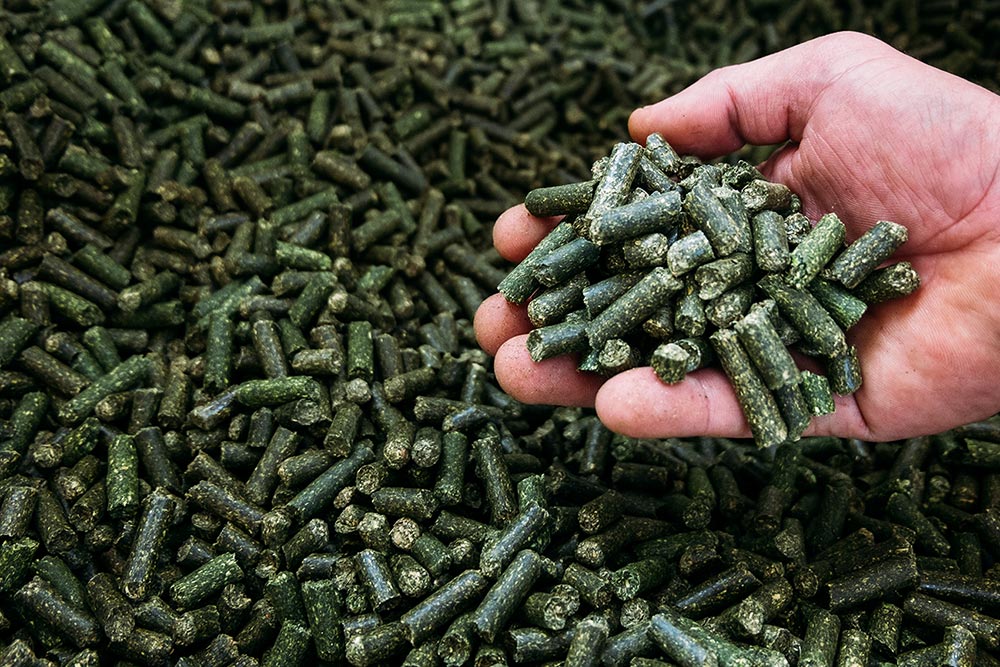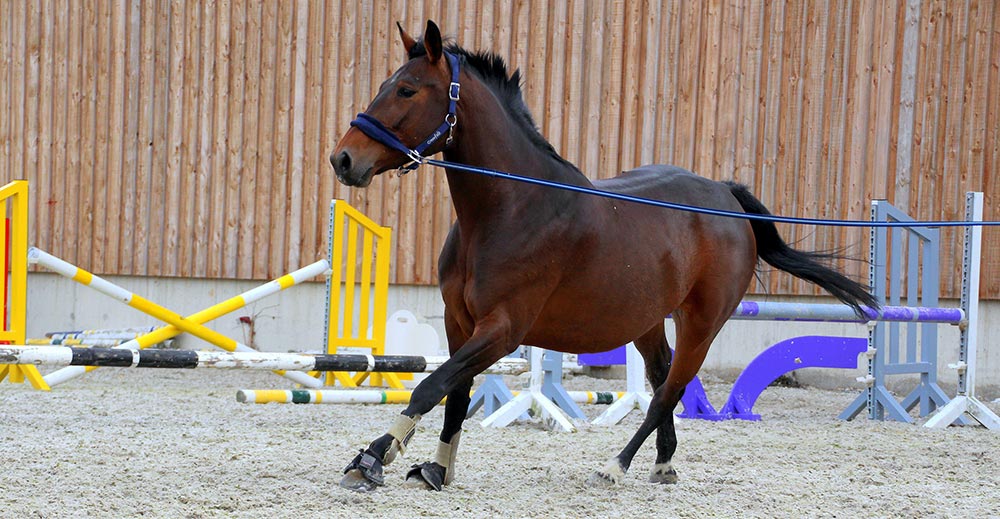15 Mar 2022
Equine gastric ulcer syndrome – complications and treatment
Plenty of articles have discussed the causes and treatments of equine gastric ulcer syndrome (EGUS), but few consider the complications of this high-incidence disease, as well as the steps owners can take to improve the animal’s outcome. In this article, Jamie Prutton reviews some of the recent literature discussing EGUS – including its aetiology, potentially additional risks that come with it, the future for diagnostic assessment, and the importance of client compliance with diagnosis and treatment.

Studies have found the incidence of equine gastric ulcer syndrome is correlated with the horse’s level of exercise.
Equine gastric ulcer syndrome (EGUS) includes two distinct syndromes: equine glandular gastric disease (EGGD) and equine squamous gastric disease.
The literature is inundated with articles discussing aetiology and treatments, although fewer articles look at complications of EGUS and how to get the best owner commitment to treatment and reducing the risk of EGUS.
This article will review some of the more recent literature, as well as discuss potential ways to work with owners.
Aetiology
Many studies have been written and peer reviewed, looking at the correlations between EGUS and the horse’s exercise plan or feed types.
Going through all these studies is beyond the scope of this article, but the major causes will be discussed briefly, while more recent work will be reviewed.
The incidence of gastric ulcers has been reviewed in several breeds, with varying exercise levels and feed types. Thoroughbred racehorses and endurance horses are those with the highest incidence of EGUS, with between 52% to 100% of horses having ulcers, dependent on the study.
The incidence is directly correlated with the level of exercise the horse was in, rather than feed, medical treatments or turnout schedule.
Other groups have showed a varying incidence, with standardbred racehorses ranging between 44% to 70%, showjumpers around 40% and show horses 58% having EGUS. On the other side, those horses that rarely compete and were stabled at home only had an incidence of 11% in one study.
Discussions that NSAIDs can induce gastric ulceration exist, and one group recently confirmed that phenylbutazone increased the frequency of ulceration, but also gastrointestinal dysbiosis (Whitfield-Cargile et al, 2021). The same group also found that by using nutritional therapeutics, the risk of ulceration could reduced.
This study, although small, showed that ongoing research into alternative treatments or, ideally, complementary dietary modifications should continue.
Interestingly, Ricord et al (2021) looked at whether using omeprazole can ameliorate the clinical side effect of phenylbutazone on gastric mucosa.
The horses in the study had no ulcers at the outset, and the group found that the EGGD score increased while on phenylbutazone compared to those on omeprazole concurrently or in the control group; albumin was only seen to decrease in those on phenylbutazone alone. These studies confirm the concern that NSAIDs will have a negative impact on gastric mucosa.
Although both studies mentioned highlight phenylbutazone, it is likely that other NSAIDs will induce similar lesions due to their similar pathways; therefore, clinicians should consider prophylactic treatment when giving NSAIDs to at-risk patients.

Diet
Feed can play a significant role in the induction, maintenance or resolution of ulcers. Previous studies have linked starvation, high-sugar diets and low-forage diets with ulceration. One problem is that horses with ulcers may also concurrently need to lose weight or have a strict diet due to equine metabolic syndrome.
Jansson et al (2021) looked at whether straw could be used as an alternative feed source to hay. Straw has historically been implicated in the induction of ulcers, but their study indicated that a 50% straw diet would not induce ulcers while improving weight loss and insulin peaks. It should be noted that this was a very small sample size (n=6) and, therefore, care should be taken when interpreting and implementing these results.
Many clinicians recommend the use of alfalfa to help reduce the occurrence of EGUS. This has historically been based on its low starch levels, as well as high magnesium and calcium levels.
Julliand et al (2021) showed that reducing half of a high-starch/energy diet with alfalfa in horses undergoing high-intensity exercise had no effect on the rate of healing of ulcers. This was a blinded study looking at 80 horses, but was a very specific question.
Concurrently, Galinelli et al (2021) reviewed how sugar may affect the rate of EGUS. They found that although sugar and starch intake over 24 hours was similar between control horses and those with EGUS, those with ulcers had higher concentrations of sugar and starch per meal, and also had a lower total forage intake.
Therefore, in the Julliand et al study looking at alfalfa supplementation, it might be that the total sugar and starch intake per meal was still high enough to cause ulcers, or that the exercise level was having a dramatic impact.
Based on previous work, the author will continue to recommend alfalfa pellets as a feed addition in horses with EGUS.

Helicobater pylori has previously been shown to have no correlation with EGUS and, therefore, antibiotic therapy as a first line treatment is not indicated.
Rezazadeh et al (2021) showed a potential correlation by finding the “duodenal ulcer-promoting” gene in the gastric fluid of three horses with severe lesions. This is a very small study and should be interpreted with care.
Significantly, the author would like to highlight that this does not indicate the need for antibiotic therapy in EGUS cases, unless based on culture and sensitivity of biopsies in cases that have not resolved to normal therapy.
Padalino et al (2020) reviewed whether transportation could lead to ulceration. They do not discuss if the transportation, change in diet or stress are the reasons for changes in gastric mucosa, but found that transportation for 12 hours increased the occurrence of gastric ulcers and, therefore, treatment in at-risk horses should be considered prior to transportation.
The use of nutraceuticals is beyond the scope of a single document. A large number of studies have looked at different supplements, but most are small studies, often without control cases; therefore, they must be interpreted with care and their use needs to be continuously evaluated as some positive outcomes have been shown, and treatments that could help are welcomed.

Complications
Most clinicians are confident about what the clinical signs of gastric ulceration are, but the question of which are evidence-based rather than anecdotal often remains.
Some of the clinical signs that have been studied and are correlated with EGUS (either squamous or glandular) include:
- poor performance including reluctance to work, slowing at the end of exercise, sudden stopping and a subsequent improvement in exercise following treatment
- recurrent or acute colic with no other aetiology
- poor body condition
- inappetence
- crib biting, although whether the ulcers or the crib biting is the inciting cause is not known
- changes in behaviour including nervousness, aggression and self-mutilation, although the literature is not as clear on these clinical signs
- poor hair coat quality, which was shown in one study, but has not been corroborated
Limited literature looks at other complications secondary to ulceration, although previous reports have shown a correlation with peritonitis and pyrexia, and these have anecdotally, in the author’s experience, been associated with gastric ulcers; therefore, a gastroscopy should be considered in some cases of pyrexia of unknown origin.
One possible post-procedure complication is colic. Spanton et al (2020a) reviewed the occurrence of colic post-gastroscopy and showed that 2.9% of cases were seen to colic within 48 hours of gastroscopy. When cases that were confirmed as gastric impaction (and, therefore, more likely to colic) were removed from the case study, the incidence went down to 0.9%.
Only one case (0.2%) required surgery due to a small intestinal volvulus, and the author has experienced a similar case in practice.
Both the study horse and the clinical case showed severe colic signs immediately after gastroscopy, which were non-responsive to analgesics.
Although it is not known whether it is causative or secondary to ulceration, a change in the microbiome within gastric fluid and pinch biopsies exists (Paul et al, 2021). Although causality is not confirmed in this paper, it could be an area of future research and treatment.
Treatment complications are not often talked about as omeprazole is deemed a safe medication. In human studies, though, it has been shown to be correlated with cardiac disease, as well as rebound gastric hyperacidosis when treatment is discontinued.
It has been shown in horses that a rebound hyperacidosis exists and, therefore, a tapered course of omeprazole is often an appropriate treatment route. Pagan et al (2020) confirmed that a reduction in the digestibility of calcium exists (but not other minerals) when on omeprazole. The reduction in digestibility was between 15% to 20%, depending on the calcium source.
Sykes (2021) questioned whether, as in humans, a correlation could exist in reduced calcium intake and an increase in the frequency of fractures.
Although the mechanisms may be similar, no cases have been presented in the literature, and most courses of omeprazole are far shorter than those in humans.
Future diagnostics
Multiple markers have been analysed to see if a non-invasive way to assess gastric ulcers exists. This has included gastrin, pepsinogen, proinflammatory cytokines and oxidative stress biomarkers.
The cytokines and oxidative stress biomarkers did show a significant difference between EGUS patients and unaffected horses, but these are not commercially available and also only confirm an inflammatory status, rather than definitively diagnose EGUS (Shawaf et al, 2020). Given those results and the clinical presentation, it would be reasonable to think that EGUS was an inflammatory state that would result in changes on blood work, which can be commercially tested.
Multiple studies, though, including one by Spanton et al (2020b), confirm that no inflammatory process is ongoing with these cases. This sits with previous studies that blood work is of limited help when trying to diagnose gastric ulcers.
Owner compliance
Owner compliance with diagnosis and treatment can be a problem. No silver bullet exists to ensure that owners do everything that is required, nor any literature looking at how to improve the outcome.
In the author’s experience, though, clear written discharge instructions can make a significant difference – particularly in non-resolving cases. A frequent occurrence exists where, when questioned at rechecks, owners will admit to not having changed the diet, turnout or exercise – even following the guidance. This often means that those changes can then be implemented alongside changes in medical therapy.
One topic frequently discussed is the duration of starvation required for treatment to be efficacious.
One study has shown an improved pH response following starvation, but multiple studies have shown a correlation between starvation and ulceration; therefore, the author recommends feeding as usual at night and then giving the omeprazole first thing and ideally waiting for one hour before feeding.
Several different protocols exist, and often they will have to be altered to fit with the horse and the owner; therefore, exact guidance cannot be given here.
Conclusions
EGUS continues to be a high-incidence disease, with a large amount of research ongoing – particularly relating to nutraceuticals.
Aetiology is relatively well understood for squamous ulceration, although less so for glandular disease; therefore, treatment must always follow appropriate medications, as well as environmental changes.
Client compliance can, in some instances, be poor and, therefore, treatment should be tailored to each horse and owner specifically.
References
- Galinelli N, Wambacq W, Broeckx BJ and Hesta M (2021). High intake of sugars and starch, low number of meals and low roughage intake are associated with equine gastric ulcer syndrome in a Belgian cohort, Journal of Animal Physiology and Animal Nutrition 105(Suppl 2): 18-23.
- Jansson A, Harris P, Davey SL, Luthersson N, Ragnarsson S and Ringmark S (2021). Straw as an alternative to grass forage in horses — effects on post-prandial metabolic profile, energy Intake, behaviour and gastric ulceration, Animals 11(8): 2,197.
- Julliand S, Buttet M, Hermange T and Julliand V (2021). Effect of replacing part of concentrates with pelleted alfalfa on squamous gastric ulcers in exercised trotters, Journal of Equine Veterinary Science 100: 103556.
- Padalino B, Davis GL and Raidal SL (2020). Effects of transportation on gastric pH and gastric ulceration in mares, Journal of Veterinary Internal Medicine 34(2): 922-932.
- Pagan JD, Petroski-Rose L, Mann A and Hauss A (2020). Omeprazole reduces calcium digestibility in thoroughbred horses, Journal of Equine Veterinary Science 86: 102851.
- Paul LJ, Ericsson AC, Andrews FM, Keowen ML, Morales Yñiguez F, Garza Jr F and Banse HE (2021). Gastric microbiome in horses with and without equine glandular gastric disease, Journal of Veterinary Internal Medicine 35(5): 2,458-2,464.
- Rezazadeh F, Pourebrahimi N, Ghotaslou R, Nasab M and Memar M (2021). Frequency of endoscopic findings of equine squamous gastric disease (ESGD) in rural horses and its association with Helicobacter pylori virulence genes, Veterinární Medicína 67(2): 61-69.
- Ricord M, Andrews FM, Morales Yñiguez FJ, Keowen M, Garza Jr F, Paul L, Chapman A and Banse HE (2021). Impact of concurrent treatment with omeprazole on phenylbutazone-induced equine gastric ulcer syndrome (EGUS), Equine Veterinary Journal 53(2): 356-363.
- Shawaf T, El-Deeb WM and Elgioushy M (2020). The contribution of specific and non-specific biomarkers in diagnosis of equine gastric ulcer syndrome (EGUS) under field condition, Journal of Equine Veterinary Science 84: 102853.
- Spanton JA, Smith L and Mair TS (2020a). A clinical audit of the prevalence of colic in the 48 hours after gastroscopy in 436 horses, Equine Veterinary Education 32(9): 12-15.
- Spanton JA, Smith L and Mair TS (2020b). Is serum amyloid A elevated in horses with equine gastric ulcer syndrome? Equine Veterinary Education 32(9): 16-19.
- Sykes BW (2021). A free ride: is long-term omeprazole therapy safe and effective? Equine Veterinary Education 33(10): 556-560.
- Whitfield-Cargile CM, Coleman MC, Cohen ND, Chamoun-Emanuelli AM, DeSolis CN, Tetrault T, Sowinski R, Bradbery A and Much M (2021). Effects of phenylbutazone alone or in combination with a nutritional therapeutic on gastric ulcers, intestinal permeability, and fecal microbiota in horses, Journal of Veterinary Internal Medicine 35(2): 1,121-1,130.
- Wise JC, Wilkes EJ, Raidal SL, Xie G, Crosby DE, Hale JN and Hughes KJ (2021). Interobserver and intraobserver reliability for two grading systems for gastric ulcer syndrome in horses, Journal of Veterinary Internal Medicine 35(1): 571-579.
